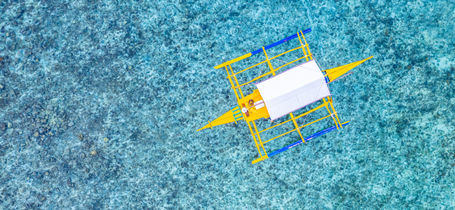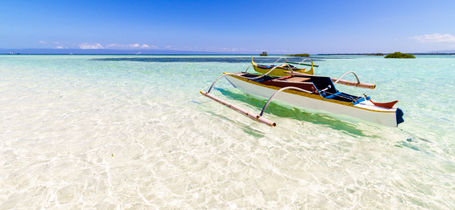Bohol Diving
With many dive resorts and hotels to choose from, plus easy access to world-class dive areas, Bohol is a great destination for new and experienced divers alike. Dive with schooling hammerheads and swirling pelagic fish, discover black coral forests, thriving macro dive sites, plunging walls and countless cliffs and caves.
Diving in Bohol
Bohol is an island in the Visayas region of the Philippines. It’s white, sandy beaches and world-renowned dive destinations make it an up and coming hotspot for divers.
Diving in Bohol encompasses several different destinations. Anda is a quiet town on the sound east tip of Bohol, which has a few select dive sites to choose from. Panglao is off the south-west coast of the island and is a dive destination by itself. With many dive resorts and hotels to choose from on the busy White Beach and Danao Beach, Panglao has something for everyone. Off the coast of Panglao lie the islands of Balicasag and Pamilacan which also have great diving. Cabilao is an island further up the coast which offers the opportunity to see schooling hammerheads. It is reached via the neighbouring island of Sandigan.
The diving here is usually great for beginners, though there are some strong drift dives too. There is outstanding biodiversity here, in terms of both corals and animal life. From tiny colourful nudibranch to big hammerheads, these islands have them all.
Best time to dive
Diving in Bohol is available all year round. The best time for diving is from November to April when the temperatures are consistently high (around 28oC), the rainfall is low and the visibility is good. May, June and July get very hot and humid but still have generally good conditions. From August to October, the weather becomes more unpredictable - alternating dry, sunny weather with rainstorms. Around Cabilao Island, hammerhead sharks are more frequently sighted from December to June.
Types of diving
As the diving in Bohol is spread over a large area, you can find your heart’s desire in the waters here. There are wall dives with caves and caverns to explore as well as more sedate sloping reefs. Most diving is ideal for beginners but some dive sites in the channels between islands have strong drifts.
Some areas in Bohol, like Panglao, have lots of dive resorts and dive centers to choose from. Mostly spread across the tourist resorts of Danao Beach and White Beach, there will be something to suit every budget. Balicasag has no dedicated place to stay and dive so it is best explored by staying in Panglao or Anda. Pamilacan and Cabilao have limited options too, but it is possible to stay on the islands if you wish.
The area is very popular with dive courses. The warm, clear waters with minimal current make this perfect for beginner divers. There are also lots of deep dives on which you can do an advanced course, or even specialist training like wreck diving, cave diving or technical diving.
Some liveaboards operate in this area. Most leave out of nearby Cebu and pass through the Visayas region. As all the dive sites are close to shore, it may be easier to have a base on an island and explore out of it each day.
What to see
The underwater landscape in the Bohol area is known as one of the most beautiful and diverse in the world. Located in the Coral Triangle, the selection of hard and soft corals plays host to an abundance of fish and reef life. Colourful fish like anemonefish, parrotfish, lionfish, soldierfish, angelfish, damselfish and butterflyfish are common on almost every dive. Other common sites include moray eels, reef sharks, octopus, cuttlefish and frogfish. The healthy reefs are great for underwater photographers as the macro life is abundant. It is also possible to see schooling hammerhead sharks in this region, a once in a lifetime opportunity.
Best places to dive
Bohol has a lot of great dive sites around it, both on Bohol and its surrounding islands, here are some of the best from each place. Cabilao is a fantastic place to see pelagic life such as barracuda, dogtooth tuna and giant trevallies. There is also the opportunity, in the early morning or dusk, to see schooling hammerheads here. The island is small but you can stay here, enjoy the laid back atmosphere and dive out of one of the two dive centers. Some of the best dive sites include Fallen Tree, Gorgonian Wall and Cambraces.
Balicasag is a small island marine sanctuary surrounded by teeming reefs. One of the best-known sites is the “Black Forest” for its abundance of black corals but also features many schools of fish including the resident shoal of jacks. The Cathedral has lots of overhangs and ledges to explore, and when the sunlight shimmers through the cracks in the rock, it is breathtaking.
Pamilacan, though small, has lots to offer. It has lots of coral and macro life and is also a great place to see ocean giants like manta rays, and even dolphins and whales! Snake Island (or Cervera Shoal) is the most famous site here, named for its local colony of black and white banded sea snakes. It is covered in huge barrel sponges and other corals, and it often visited by pelagics like reef sharks, whale sharks and manta rays. Pamilacan Island Reef has plenty to offer without going further afield. The reef hosts shoals of fish, hunting fish like trevally and tuna and a group of resident turtles.
Anda is known for its perfect white beaches and its countless cliffs and caves. These form an important part of the diving here. Neptune’s House is a cave with an entrance at 31m that is filled with lobsters and blue spotted stingrays. There are also lots of steep walls to discover like Lumayak and Paradise Garden as well as other cave and grotto systems.
Panglao has the biggest and most developed diving scene in the area - there are over 20 dives around this island alone.
Arco Point is also known as “Hole in the Wall” because of its swim through which starts at 18m. There are plenty of camouflaged animals to find here like scorpionfish and frogfish which nestle on the walls. The current here can be strong. Doljo Point has amazing coral gardens with lots of gorgonian sea fans, brain corals, whip corals and bucket sponges to admire. If you go to the reef’s deep drop off point, you might be rewarded with sightings of hammerheads, manta rays and whale sharks out in the blue.
The Bohol Beach Club (BBC) has a sloped wall with the wrecks of two (now mostly collapsed) jeepneys which are covered in corals. This is a great spot for a night dive as there are lots of small caves for critters to hide in. Be sure to bring your torch to look for unusual nudibranch, ghost and mushroom pipefish and all manner of crustaceans.


